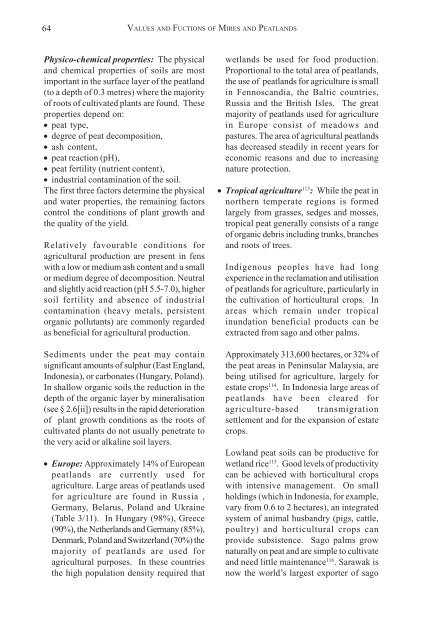wise use of mires and peatlands - Peatland Ecology Research Group
wise use of mires and peatlands - Peatland Ecology Research Group
wise use of mires and peatlands - Peatland Ecology Research Group
Create successful ePaper yourself
Turn your PDF publications into a flip-book with our unique Google optimized e-Paper software.
64 VALUES AND FUCTIONS OF MIRES AND PEATLANDSPhysico-chemical properties: The physical<strong>and</strong> chemical properties <strong>of</strong> soils are mostimportant in the surface layer <strong>of</strong> the peatl<strong>and</strong>(to a depth <strong>of</strong> 0.3 metres) where the majority<strong>of</strong> roots <strong>of</strong> cultivated plants are found. Theseproperties depend on:● peat type,● degree <strong>of</strong> peat decomposition,● ash content,● peat reaction (pH),● peat fertility (nutrient content),● industrial contamination <strong>of</strong> the soil.The first three factors determine the physical<strong>and</strong> water properties, the remaining factorscontrol the conditions <strong>of</strong> plant growth <strong>and</strong>the quality <strong>of</strong> the yield.Relatively favourable conditions foragricultural production are present in fenswith a low or medium ash content <strong>and</strong> a smallor medium degree <strong>of</strong> decomposition. Neutral<strong>and</strong> slightly acid reaction (pH 5.5-7.0), highersoil fertility <strong>and</strong> absence <strong>of</strong> industrialcontamination (heavy metals, persistentorganic pollutants) are commonly regardedas beneficial for agricultural production.Sediments under the peat may containsignificant amounts <strong>of</strong> sulphur (East Engl<strong>and</strong>,Indonesia), or carbonates (Hungary, Pol<strong>and</strong>).In shallow organic soils the reduction in thedepth <strong>of</strong> the organic layer by mineralisation(see § 2.6[ii]) results in the rapid deterioration<strong>of</strong> plant growth conditions as the roots <strong>of</strong>cultivated plants do not usually penetrate tothe very acid or alkaline soil layers.●Europe: Approximately 14% <strong>of</strong> Europeanpeatl<strong>and</strong>s are currently <strong>use</strong>d foragriculture. Large areas <strong>of</strong> peatl<strong>and</strong>s <strong>use</strong>dfor agriculture are found in Russia ,Germany, Belarus, Pol<strong>and</strong> <strong>and</strong> Ukraine(Table 3/11). In Hungary (98%), Greece(90%), the Netherl<strong>and</strong>s <strong>and</strong> Germany (85%),Denmark, Pol<strong>and</strong> <strong>and</strong> Switzerl<strong>and</strong> (70%) themajority <strong>of</strong> peatl<strong>and</strong>s are <strong>use</strong>d foragricultural purposes. In these countriesthe high population density required that●wetl<strong>and</strong>s be <strong>use</strong>d for food production.Proportional to the total area <strong>of</strong> peatl<strong>and</strong>s,the <strong>use</strong> <strong>of</strong> peatl<strong>and</strong>s for agriculture is smallin Fennosc<strong>and</strong>ia, the Baltic countries,Russia <strong>and</strong> the British Isles. The greatmajority <strong>of</strong> peatl<strong>and</strong>s <strong>use</strong>d for agriculturein Europe consist <strong>of</strong> meadows <strong>and</strong>pastures. The area <strong>of</strong> agricultural peatl<strong>and</strong>shas decreased steadily in recent years foreconomic reasons <strong>and</strong> due to increasingnature protection.Tropical agriculture 113 : While the peat innorthern temperate regions is formedlargely from grasses, sedges <strong>and</strong> mosses,tropical peat generally consists <strong>of</strong> a range<strong>of</strong> organic debris including trunks, branches<strong>and</strong> roots <strong>of</strong> trees.Indigenous peoples have had longexperience in the reclamation <strong>and</strong> utilisation<strong>of</strong> peatl<strong>and</strong>s for agriculture, particularly inthe cultivation <strong>of</strong> horticultural crops. Inareas which remain under tropicalinundation beneficial products can beextracted from sago <strong>and</strong> other palms.Approximately 313,600 hectares, or 32% <strong>of</strong>the peat areas in Peninsular Malaysia, arebeing utilised for agriculture, largely forestate crops 114 . In Indonesia large areas <strong>of</strong>peatl<strong>and</strong>s have been cleared foragriculture-based transmigrationsettlement <strong>and</strong> for the expansion <strong>of</strong> estatecrops.Lowl<strong>and</strong> peat soils can be productive forwetl<strong>and</strong> rice 115 . Good levels <strong>of</strong> productivitycan be achieved with horticultural cropswith intensive management. On smallholdings (which in Indonesia, for example,vary from 0.6 to 2 hectares), an integratedsystem <strong>of</strong> animal husb<strong>and</strong>ry (pigs, cattle,poultry) <strong>and</strong> horticultural crops canprovide subsistence. Sago palms grownaturally on peat <strong>and</strong> are simple to cultivate<strong>and</strong> need little maintenance 116 . Sarawak isnow the world’s largest exporter <strong>of</strong> sago
















